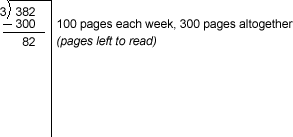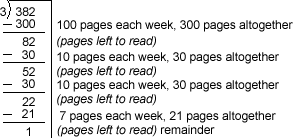Math 5 - Act. 04: Partial Quotient
Summary
This activity is designed to help students understand what occurs in the division process, rather than just following prescribed steps.
Materials
Additional Resources
Divide and Ride by Stuart Murphy deals with interpreting remainders.
Background for Teachers
Attachments
-
division_baseten.pdf
Division - Using Base Ten Blocks
Teach this method of division to your students before the traditional algorithm. It shows what occurs in the division process rather than just prescribing steps to follow. Students should have worked with multiplication patterns like:
6 x 2 = 12
6 x 20 = 120
6 x 200 = 1200
Students should have explored division with Base Ten Blocks as shown on the accompanying page.
Intended Learning Outcomes
1. Demonstrate a positive learning attitude toward mathematics.
2. Become mathematical problem solvers.
6. Represent mathematical situations.
Instructional Procedures
Attachments
-
division_example.pdf
Division Example for TI-73 -
Math5st1ob5a.gif
-
Math5st1ob5c.gif
-
Math5st1ob5d.gif
Invitation to Learn
Pose a problem such as, "My library book has 382 pages. I have three weeks
before I need to return it. How many pages do I need to read each week to finish
it in time?" Let the students work on this for 10-15 minutes and share
some of the strategies they used to figure it out. This can act as a pretest
to see how much your students know about division.
Instructional Procedures
- Discuss some of the strategies used on the original problem.
- Write the problem 382 ÷ 3 on the board. Create a chart that says:
Week 1 Week 2 Week 3 . . .
Along with the division problem written like this:

- Start by showing your students that you could start tallying that you read
one page each week and keep repeating this until you have 382 tally marks.
Show how this would look using repeated subtraction on the division problem.
Week 1 Week 2 Week 3 ///
///
///
382
- 3
1 page each week, subtract 3 pages altogether 379
(pages left to read) - 3
1 page each week, subtract 3 pages altogether 376
(pages left to read) - 3
1 page each week, subtract 3 pages altogether 373 (pages left to read)
Point out that we could go on like this until we finished dividing all the pages but that would take us a long time. Erase what you just entered into your chart and on your division problem. - Ask students if we could divide a greater number of pages instead of one
by one. Students will see that we could read 100 each week and then see how
many we have left to read.
Week 1 Week 2 Week 3 100
100
100

- What could we use next? One by one would still take a long time. Students
will give different responses like:
10 pages each week and subtract 30 pages
20 pages each week and subtract 60 pages.
Responses will vary depending on the students' ability to use multiplication patterns. The great thing about this strategy is that you can use either number and just keep subtracting and see what you still have left to divide. That is why we call it "Using What You Know." Every student could use a different number and still arrive at the same answer. - Continue filling in the chart and division problem.
Week 1 Week 2 Week 3 100
10
10
7100
10
10
7100
10
10
7

- Add up our pages down the side and see if they match with one week of our chart. Record the answer to the problem where it belongs.
- Discuss how to interpret the remainder. We have to read 127 pages each week but on the third week you have to read 128.
- Practice several more of these problems always creating a word problem that goes with it. This helps students to understand what the remainder actually means. Students enjoy coming up with the stories to go with the problems.
Curriculum Integration
Math/Science--Use the Math by Hand Application for the TI-73 calculator
to demonstrate the same process.
Extensions
Possible Extensions/Adaptations
Use this activity to begin discussing different ways of interpreting remainders.
Because students are coming up with different problem situations, their remainders
may be interpreted differently. Did you need to ignore it, round up, or report
it as a fraction or decimal?
Homework & Family Connections
Many parents have not seen this strategy for division. Have the students explain
it to their parents. Let the students know that they are to practice this strategy
alone and not look at the traditional algorithm yet.
Assessment Plan
Attachments
Give the students a number sentence such as 413 ÷ 8. Have them write a word problem for the number sentence, and identify which number is the dividend and which is the divisor. Tell students to solve the problem and explain the steps they used. Have them name the quotient and remainder, and explain what the remainder means in the solution.
Updated: 02/05/2018


 UTAH EDUCATION NETWORK
UTAH EDUCATION NETWORK

 Justin
Justin Braxton
Braxton Dani
Dani Kayla
Kayla Katie
Katie Matthew
Matthew Rob
Rob Val
Val
